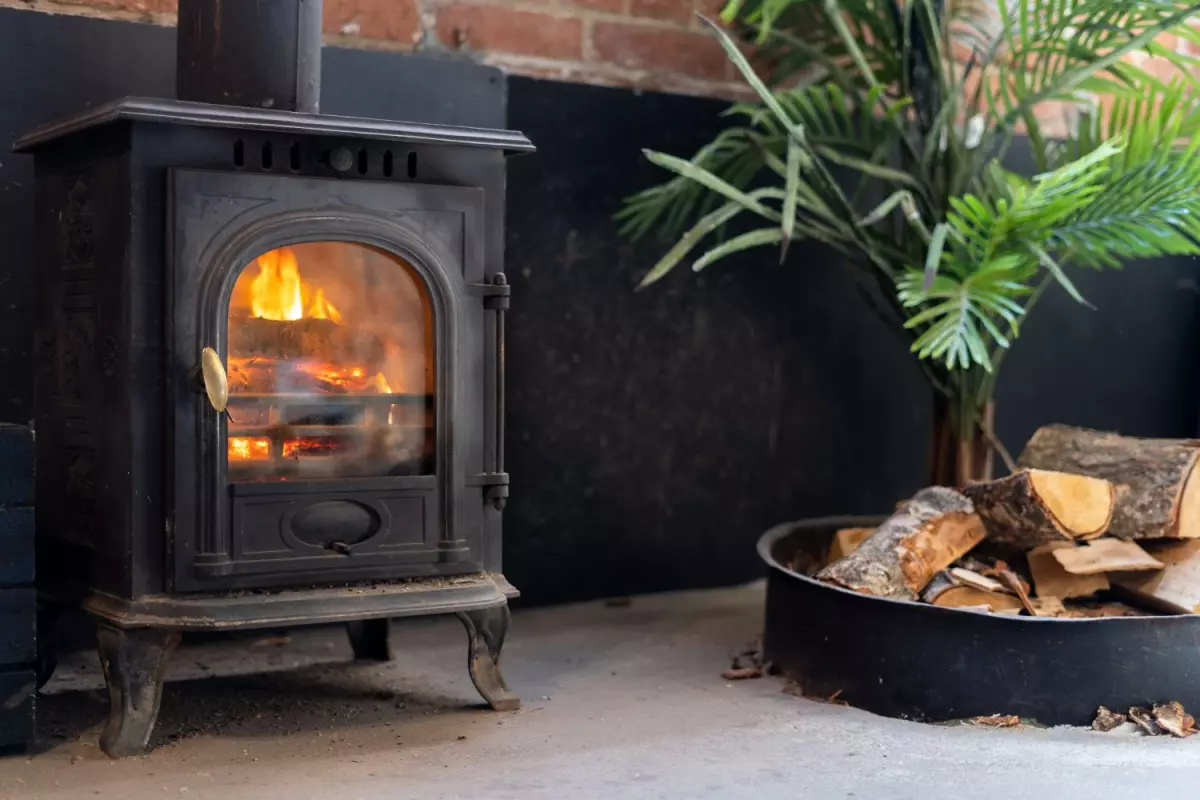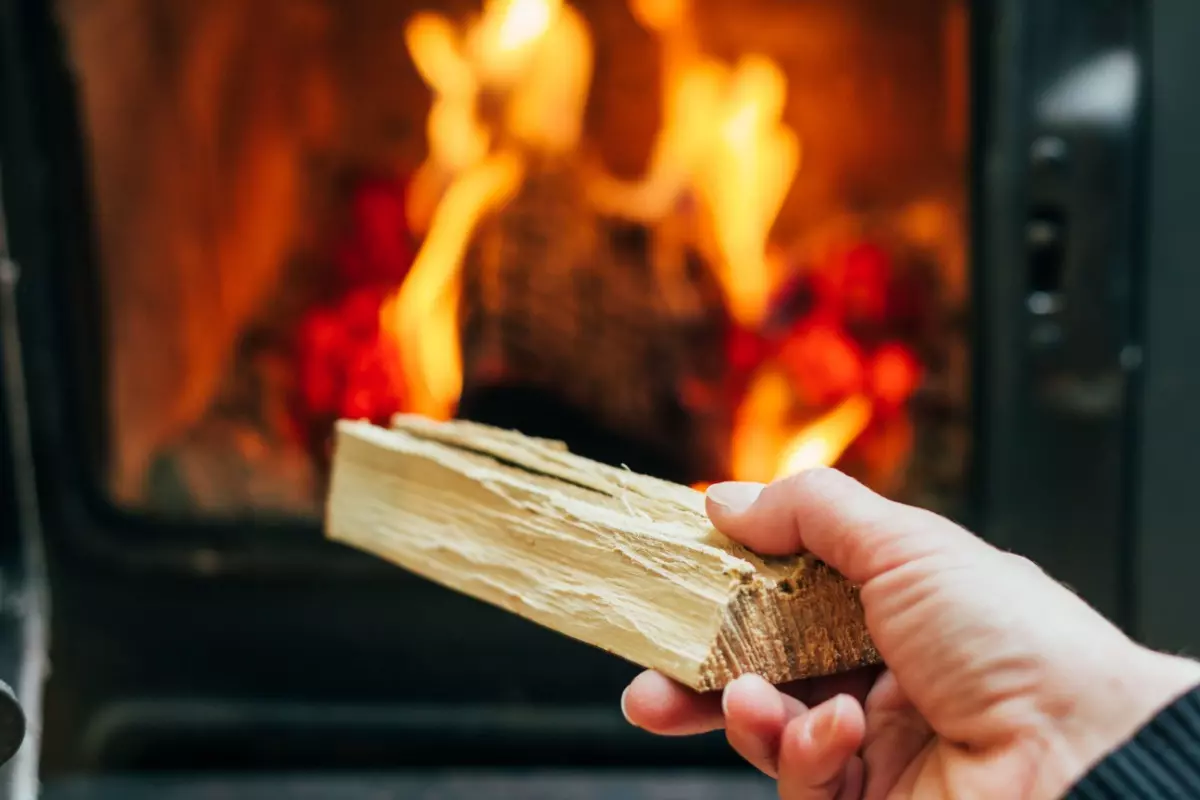As winter rears its head again, you may be looking for ways to lift the temperature without increasing your energy bills. A log burner can help, turning seasoned wood into steady, room-warming heat and a cosy focal point.
In this guide, we break down the cost of a log burner installation, explain why prices vary depending on your setup, outline the relevant rules and certifications to be aware of, and offer smart ways to save without compromising quality.
Installing a log or woodburner in the UK typically costs around £2,000 on average, though prices can range anywhere from £700 to £3,500.

If your home already has a working chimney and hearth, you’re looking at roughly £800 to £1,500 for a simple fitting. Usually just the stove, a flue liner, and the labour.
Things get pricier when there’s no chimney and you’re starting from scratch. A full installation with a new insulated flue or structural work can reach £3,000 to £4,000.
From chimney work and hearth prep to labour and safety extras, here are the factors that shape your final price.
Every home has its own starting point, and that’s what decides the cost of log burner installation. These three examples outline what that looks like for a standard 5 kW stove.
If your house already has a working chimney and a decent fireplace, you’re starting in the best possible spot. The installer can focus on fitting the stove and lining the chimney to make it airtight.
Typical cost: £700 to £1,500.
At the lower end, you’re looking at a quick fit. Maybe your chimney’s in good shape, already lined, and just needs a register plate.
Around £1,500, the job usually includes a full liner, cowl, and a few small adjustments to the fireplace.
What’s usually included:
What to check:
Get the chimney swept first — installers won’t start otherwise. Make sure your hearth extends at least 150 mm to each side and 225 mm in front for closed stoves (or 300 mm if the appliance can be used with the door open).
A home without a chimney isn’t a dealbreaker, it just changes the job. The installer will add a twin-wall insulated flue, running it through the roof or up an outside wall like a stainless-steel chimney.
Typical cost: £1,500 to £3,500.
Flue parts alone often cost around £1,000 to £2,000, and with labour, most two-storey homes end up around the £2,500 mark.
Complex runs or premium stoves can push this closer to £5,000.
What’s usually included:
What to check:
Most flues don’t need planning permission, but if your property’s listed or in a conservation area, you’ll need approval. The flue can legally extend 1 m above the roof ridge without consent.
A good installer will plan the flue route for maximum draw and minimal visual impact.
An open fire uses a large chimney and a wide opening to let smoke travel. A woodburner works best in smaller, enclosed spaces that have a properly sized flue for airflow.
Upgrading is a great way to get more heat from the same space. The installer removes the old fire grate and prepares the opening, then lines the chimney, seals it, and fits the stove securely in place.
Typical cost: £1,000 to £2,000 for a full replacement, assuming no major surprises.
If the fireplace opening needs resizing or you need to rebuild the hearth, that adds an extra £500 to £700 to the woodburner installation cost.
What’s usually included:
To put the log burner installation cost into perspective, here’s how a typical job breaks down.
| Cost Item | Average Price Range (UK) |
| Wood-burning stove | £900–£1,500 |
| Flue liner (existing chimney) | £300–£500 (materials) up to £1,000–£1,500 for full installation |
| Twin-wall flue system (no chimney) | £2,000–£3,000 |
| Hearth or surround work | £150–£300 (basic) £500–£1,000+ (custom) |
| Labour | £500–£1,500 (standard) £1,500–£3,000 (complex) |
| Chimney sweep | £50–£100 |
| Roof or access equipment | £200–£650 |
| Small parts & fittings | £100–£250 |
| Carbon monoxide alarm | £21–£75 |
Prices include VAT (at 20%) unless noted.
Aim to get at least three detailed quotes from qualified, HETAS-registered installers, and don’t be afraid to ask questions.
Tell the installer if you already have a chimney, what type of property you live in (bungalow, two-storey, etc.), and whether there’s an existing fireplace. Mention anything unusual, like a thatched roof.
A quick site visit helps them price the job accurately — many offer this for free.
Ask exactly what the quote covers. It should clearly spell out parts and what’s covered rather than just a vague line that says “installation.”
If your fireplace needs widening, or a new hearth built, ask whether the installer handles that or if you’ll need a builder separately.
Some installers do both; others only fit the stove and flue. Make sure these costs are itemised to avoid unexpected add-ons.
Confirm that they’ll provide a HETAS certificate. If they’re not registered, you’ll need to involve your local Building Control office, which adds time and expense.
Check whether the quote includes a carbon monoxide alarm, which is required under Building Regs Approved Document J when fitting any new/replacement solid-fuel appliance; your installer should fit and test a CO alarm in the room.
Ask how long the job will take and what to expect. A simple install might take a day; adding a flue or rebuilding a hearth can take two or three.
See if there’s anything you can do beforehand, such as protecting carpets or arranging a chimney sweep.
If you haven’t bought a stove yet, ask which brands or models they recommend. Many installers can supply stoves at trade prices or suggest models that suit your room size.
UK law has clear rules for log burner installations. They’re there to make sure your stove runs safely and burns cleanly.

HETAS-registered installers are qualified to fit the stove, test the flue, and register the work with your local council. You’ll then get a HETAS certificate, which acts as proof the job meets legal safety standards.
A HETAS-registered installer can self-certify and issue a HETAS Certificate of Compliance, which notifies Building Control; DIY or non-registered installations must be inspected by Local Building Control instead.
You won’t normally need planning permission to install a stove inside your home. The exception is when adding or extending an external flue.
As long as it’s no more than 1 metre above the roof ridge and not on the front of a conservation area property, it counts as permitted development.
If you live in a city or large town, your home is likely in a Smoke Control area. In Smoke Control Areas, you must burn authorised fuels or use a DEFRA-exempt (Smoke Exempt) appliance to burn wood.
The simple solution is to choose a DEFRA-approved stove, also called Smoke Exempt. These stoves burn cleanest with dry seasoned logs.
You can check if your area is affected on your local council’s website or through the UK Government Smoke Control map.
Always fit a carbon monoxide alarm in the same room as your stove. Place it high on a wall or ceiling, a couple of metres from the burner. Test it often.
Add a smoke alarm nearby and keep anything flammable well away from the stove.
Here are smart, safe ways to keep your log burner installation cost under control without cutting corners.
Autumn is the busiest time for stove installers. Try booking in spring or summer, when demand dips and discounts are common.
Some retailers also run off-season sales on stoves and flue kits.
Bigger isn’t always better. A 5 kW stove usually heats an average living room comfortably and avoids the need for extra ventilation.
If your home already has a usable chimney or hearth, plan around it. Installing the stove in an existing fireplace is far cheaper than adding a brand-new flue elsewhere.
Ask your installer if your chimney can be relined rather than rebuilt — it can save hundreds.
You can safely handle small prep tasks before the installer arrives. Leave all structural and gas work to the pros, but clear the area and cover your floors. It’ll shave off a few hours of labour time.
A stove with Ecodesign approval and an efficiency rating of 80 % or higher burns less wood and needs less sweeping. You’ll spend more upfront but save long-term on fuel and maintenance.
Skip pricey add-ons like ornate mantels or built-in log stores until later. Focus on getting a safe, functional install first. You can always add aesthetic upgrades once your budget allows.
A log burner is one of those upgrades that pays off in warmth and atmosphere, but the upfront cost can add up fast. If you’d rather spread the expense, look into stove financing.
It usually costs between £700 and £3,500 in the UK, depending on whether you already have a chimney or need a new flue system fitted.
Not usually. Most installations fall under permitted development, but you’ll need approval if you live in a listed building or a conservation area and plan to add an external flue.
For a typical 5 kW stove with fitting and liner, expect around £2,000 in total. Custom fireplaces or larger builds can go higher.
You can, but it’s not as simple as slotting in a stove and lighting a fire. The work must meet regulations and be checked by your local council.
Most homeowners choose a HETAS-registered installer, who can fit and certify it in one go, saving you paperwork and potential safety issues.
A simple install is often finished in one day. Adding a new flue or rebuilding a hearth can take two to three days.
Have the chimney swept at least once a year and service it annually if you can.
Yes. Insurers see log burners as a fire risk, which can raise premiums or add conditions. Most require professional installation, proof of safety checks, and working alarms.
Always tell your insurer before fitting one to keep your policy valid.

(All content, including text, images, logos, and other materials, is the intellectual property of Renovate Dot UK Limited unless otherwise stated. You may not reproduce, distribute, or otherwise use the content for commercial purposes without prior written consent)
Every effort is made to keep the website up and running smoothly. However, Renovate Dot UK Limited takes no responsibility for, and will not be liable for, the website being temporarily unavailable due to technical issues beyond our control.
This disclaimer and all matters relating to your use of this website are governed by the laws of England and Wales, and any disputes shall be subject to the exclusive jurisdiction of the courts of England and Wales.